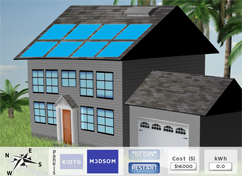Sun Banking

Many homeowners face large bills from their electricity charges each month. Increasing fossil fuel costs associated with making electricity are frequently passed onto consumers in the form of higher energy bills. Many have proposed that solar power can be used to reduce traditional electricity consumption. Can you determine if solar energy is a viable energy resource? You’ll have to be bright to find out.
What is electrical energy?
Electrical energy is defined as the energy associated with moving electrons through a conductor. Although electrons are continually moving in an atom, the electrons can be forced to move in a desired direction. This movement of electrons is commonly called electricity. A vast majority of device in U.S. homes operate using electrical energy. Heating and cooling homes account for the largest electricity demand, while lighting and powering devices, such as televisions and computers accounts for less than 25% of the total electrical energy used in homes.How is most electrical energy produced?
The normal process for converting electrical energy from other forms of energy is basically the same. First, liquid water is heated and changed into steam. This step varies depending on which type of fuel is used to heat the water. Coal (most commonly used), natural gas, nuclear reactions, and petroleum are typical fuels used for making the steam. The steam is then directed towards a blade that spins. The spinning blade turns a generator that converts the mechanical energy into electrical energy via electromagnetic induction. A downside of this type of electrical energy production is the contamination of the environment due to burning the various fuels that heat the water. A second problem associated with this process is that most of the fuel sources are limited and nonrenewable, which means the fuels will eventually run out and new fuel sources will have to be found.What is the difference between passive and active solar energy?
Passive solar energy involves the positioning of windows, shades, and other devices to maximize the amount of sunlight reaching the inside of a structure during the winter months and minimize the amount during the summer season. Using passive energy approaches can be as simple as pulling down a window shade to block the sunlight to keep a house cooler during the summer. Active solar energy involves the collection of sunlight using solar collectors, such as metal tubes filled with water to heat the water or using photovoltaic cells to directly convert sunlight into electrical energy.What are photovoltaic cells?
Photovoltaic cells are devices that directly change sunlight into electrical energy. Photovoltaic cells are made from semiconducting materials, such as different silicon compounds. These cells produce direct current that can be used to power a variety of devices or to recharge batteries. Improvements in photovoltaic cell technology and the mass production of these cells have lowered the cost, so more applications of the cells arise on a daily basis. If the explosion in the use of solar cells increases at the same rate as in the past, solar cells could provide all of the world's current energy needs by around the year 2030. Current photovoltaic cell energy conversion efficiency ratings only average about 15%; however, improvements are expected that will bring their efficiencies closer to 50%.What is a solar panel?
A solar panel is a collection of solar cells arranged in a grid to collect larger amounts of sunlight than using a single photovoltaic cell. Solar panels are usually located on roofs and positioned to collect the largest amount of sunlight possible during the various seasons. A larger solar panel featuring a greater number of solar cells would collect more sunlight than a smaller panel under similar conditions.Walkthrough
Tier 2 Lessons: Grades 7 - 12+
You need to log in to access this simulation.



